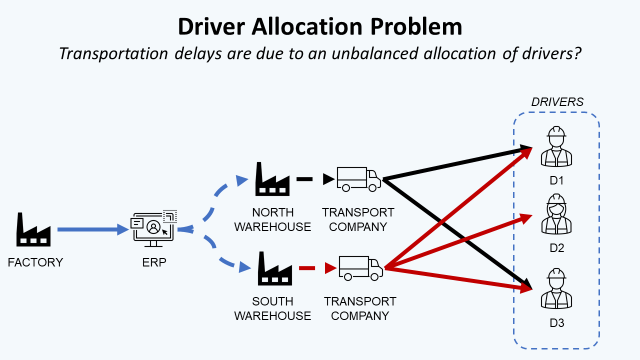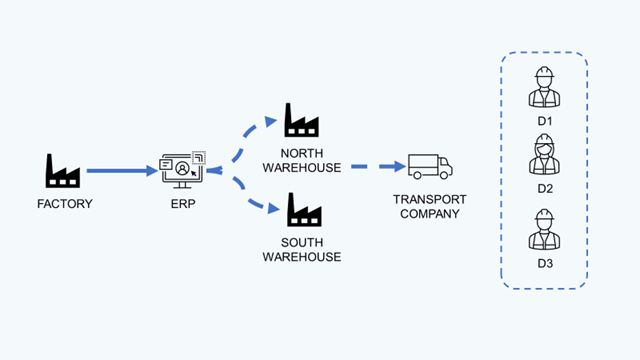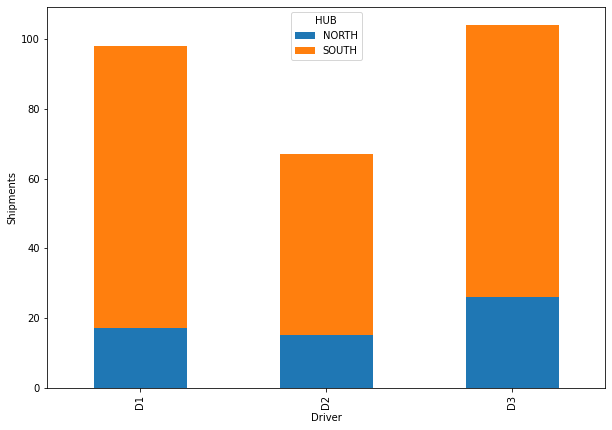Lean Six Sigma with Python — Chi-Squared Test
Perform a Chi-Squared Test to explain a shortage of drivers impacting your transportation network.

In the logistics industry, improving your operations constantly and adapting to changes is essential.
Lean Six Sigma (LSS) with Python is a stepwise approach to process improvements using statistical tools to test hypotheses.
As a Data Scientist, how can you solve operational issues with LSS?
In a previous article, we used the Kruskal-Wallis Test to verify the hypothesis that specific training improves warehouse productivity.
Which tool can we use to help transportation operations?
In this article, we will implement the Chi-Squared Test with Python to understand if transportation delays are due to an inadequate allocation of drivers.
SUMMARY
I. Problem Statement
Transportation delays are due to drivers' allocation issues?
II. Exploratory Data Analysis
1. Exploratory Data Analysis
Analysis with Python sample data from historical records
2. Perform Cross Tabulation
Summarise the relationship between several categorical variables.
3. Pearson’s Chi-Square Test
Validate that your results are significant and not due to random fluctuation
III. Conclusion
1. Generative AI: Lean Six Sigma x GPT
2. Next StepsProblem Statement
Addressing Transportation Delays with Chi-Squared Test
You are a data scientist at a manufacturing company.
You support the Inbound Transportation Manager of a small factory in the United States.
The transportation network is simple, with only two routes
- Route 1: coming from your northern regional hub (with difficult road conditions and heavy traffic)
- Route 2: coming from your southern regional hub (with no traffic and a beautiful modern road)
Transportation is managed by an external service provider with a fleet of three trucks (with three different drivers: D1, D2, D3).

Can we assess routes performance using data analytics?
Understanding Driver Allocation in Transportation Network
When a factory needs replenishment,
- The Factory sends a replenishment order to your ERP
- The Southern regional hub receives the order first
- If the stock in the southern hub is too low, then the order is transferred to the northern hub
- ERP sends a pick-up request to the transportation service provider (From the Selected Hub to the Factory)
- The first driver accepting the request is delivering the raw materials to the factory
P.S.: As a customer, we do not have any visibility on the process of driver allocation.
Problem
When an order is allocated to the northern regional hub, the lead time to get the request accepted is 35% longer than that of the southern hub.
Are there drivers avoiding as much as possible to be allocated to the north route?
Experiment
We have analyzed the shipments of the last 18 months to build a sample of 269 records.
The objective is to use statistical tools with Python to answer this question.
🏫 Discover 70+ case studies using data analytics for supply chain sustainability🌳and business optimization 🏪 in this: Cheat Sheet
Exploratory Data Analysis
Stacked Bar Charts to Visualize Driver Allocation
Let’s have a look at the driver's allocation.

Can you see something significant?
Cross Tabulation: Analyzing Shipments by Hub and Driver
A cross-tabulation of the data can provide some insights and help us discover a potential pattern in the repartition of driver’s allocation.
Example
82.65 % of shipments handled by Driver 1 are from SOUTH HUB
Example
38.89 % of shipments from SOUTH HUB are handled by Driver 1
Minitab
Menu Stats> Tables > Cross Tabulation and Chi-Square We can see an unbalanced allocation.
What’s next?
Pearson’s Chi-Squared Test: Evaluating the Significance of Driver Allocation
The first table is called also called a Contingency table. It is used in statistics to summarise the relationship between several categorical variables.
Can we prove statistically that the hub impacts the allocation?
Using the Chi-Squared Test, we calculate the significance factor to determine whether the relationship between the variables is significant.
p-value is 0.410Conclusion
Because the p-value >0.05, there is no significant proof that the driver’s allocation is linked to the Hub.
Code
Based on the patterns in the data, we don’t have proof that drivers prefer a specific route.
We need to investigate more to find the root cause of our delays.
Conclusion
By applying the Chi-Squared Test in Python, we could determine that driver allocation was not the root cause of the transportation delays.
This data-driven approach helped us identify areas for further investigation to find the actual cause of the problem.
Can we solve other operational issues using the same approach?
Yes!
The articles below will help you learn about the Lean Six Sigma methodology applied to warehouse operations.
Have you heard about Generative AI?
Generative AI: Lean Six Sigma GPT Agent
After the recent adoption of Large Language Models (LLMs) like GPT, we can enhance the user experience of analytics products with smart agents.
In this article, I shared my first experiment, the design of a LangChain Agent connected to a TMS.

The outputs are impressive.
We have an agent that can answer operational questions by querying a database autonomously.
What if we create a Lean Six Sigma super agent?
My objective is to equip a GPT agent with
- Python Scripts of Lean Six Sigma Tools
- Context, articles and knowledge about LSS mathematical tools

So we have an agent that can find the proper test, perform it on data uploaded by users and provide an answer.
For more information,
About Me
Let’s connect on Linkedin and Twitter. I am a Supply Chain Engineer who uses data analytics to improve logistics operations and reduce costs.
For consulting or advice on analytics and sustainable supply chain transformation, feel free to contact me via Logigreen Consulting.
If you are interested in Data Analytics and Supply Chain, look at my website.
💌 New articles straight in your inbox for free: Newsletter
📘 Your complete guide for Supply Chain Analytics: Analytics Cheat Sheet
If you prefer to watch, have a look at the video version of this article
References
- Pearson’s Chi-Squared Test, geeks for geeks, link
